Air Temperatures – The following high temperatures (F) were recorded across the state of Hawaii Monday…along with the low temperatures Monday:
86 – 73 Lihue, Kauai /
88 – 76 Honolulu, Oahu /
89 – 75 Molokai AP
87 – 70 Kahului AP, Maui /
84 – 72 Kona AP, Hawaii
86 – 73 Hilo, Hawaii /
Here are the latest 24-hour precipitation totals (inches) for each of the islands Monday evening:
0.43 Mount Waialeale, Kauai
0.38 Poamoho RG 1, Oahu
0.10 Molokai
0.00 Lanai
0.00 Kahoolawe
0.61 Puu Kukui, Maui
0.72 Kawainui Stream, Big Island
The following numbers represent the strongest wind gusts (mph) Monday evening:
13 Makaha Ridge, Kauai
23 Kuaokala, Oahu
17 Molokai
20 Lanai
28 Kahoolawe
28 Maalaea Bay, Maui
25 Kealakomo, Big Island
Hawaii’s Mountains – Here’s a link to the live webcam on the summit of our tallest mountain Mauna Kea (~13,800 feet high) on the Big Island of Hawaii. Here’s the webcam for the ~10,023 feet high Haleakala Crater on Maui. These webcams are available during the daylight hours here in the islands, and at night whenever there’s a big moon shining down. Also, at night you will be able to see the stars, and the sunrise and sunset too…depending upon weather conditions.
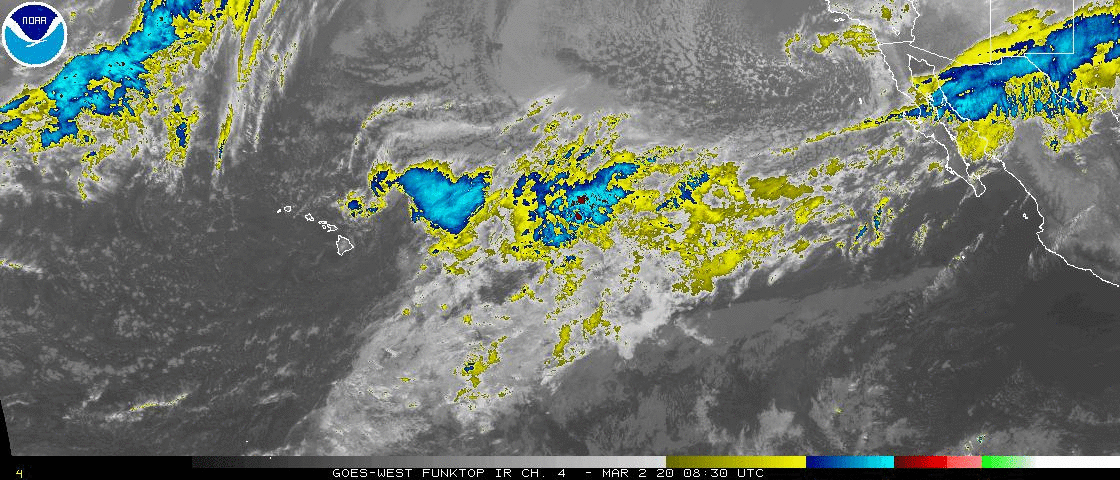
A cold front just northwest of Hawaii
(click on the images to enlarge or animate them)
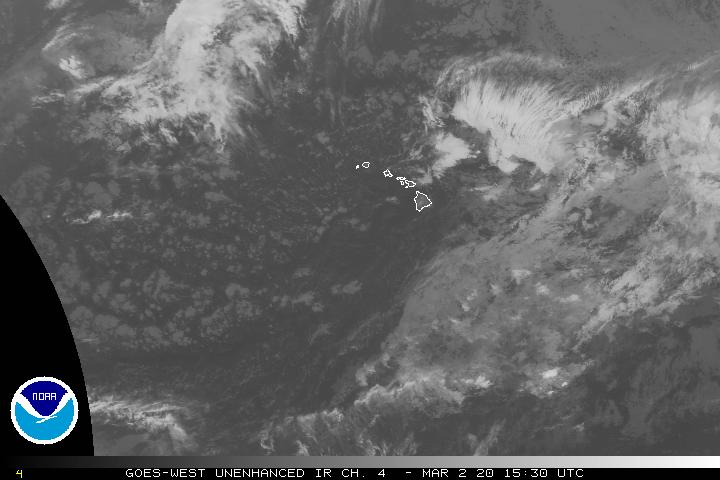
Thunderstorms offshore…in several directions

Partly to mostly cloudy…clear areas locally

Showers falling locally
Looping image
Small Craft Advisory…pink color below
High Surf Advisory…purple color below
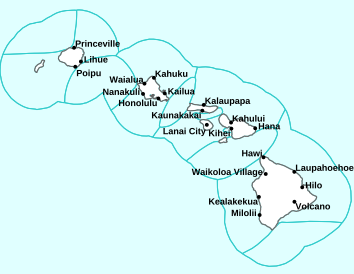
~~~ Hawaii Weather Narrative ~~~
Broad Brush Overview: The trades will continue, although will weaken significantly Tuesday and Wednesday, with light and variable winds then persisting through the rest of the week. These trades will carry clouds and passing showers…mainly to windward areas. As the winds lighten up, clouds and showers will develop over island interiors during the afternoons, with clearing at night. A passing disturbance aloft may lead to some heavier afternoon showers Tuesday into Thursday, followed by drier weather Friday into the weekend.
Details: Weather maps show a slow moving cold front stalled northwest of Kauai, along with a pair of highs far northeast and northwest. The resulting pressure gradient south of these highs, remains strong enough to keep moderately strong northeast to easterly trades over our area, with scattered clouds and showers riding along on the trades.
The trades will trend down as the cold front edges closer to the islands, prompted by an approaching trough of low pressure aloft. Generally stable conditions should continue, with showers remaining focused over windward slopes. A further decrease in winds and an increase instability, is expected Tuesday…which lingers into Thursday.
The models show lighter east to southeast breezes Tuesday, becoming light and variable Wednesday through Friday, as a weak low forms along the front to the north. Even if a low doesn’t form, low pressure troughing to the north will keep winds very light, with a land and sea breeze regime over the islands by Tuesday afternoon. While the greatest instability associated with the low aloft will remain north of the islands, it could generate enough instability to produce locally heavy showers…especially during the afternoon hours Tuesday-Thursday.
Looking Further Ahead: As we push into Friday and Saturday, the potential for heavy showers is expected to diminish, as the low aloft moves away to the northeast. Isolated showers should favor island interior areas each afternoon, although there doesn’t look to be sufficient moisture or instability to drive heavy shower development. Look for clouds and a few spotty showers to develop over land each afternoon…followed by partial clearing at night.
Meanwhile, the most reliable models are showing the large scale trough northwest of Hawaii deepening once again by the weekend. By Saturday this should maintain light winds, or possibly strengthening south to southwest kona winds near Kauai and Oahu, as a cold front advances toward the islands from the northwest. The front is currently expected to stall near Kauai Sunday or next Monday, with mostly dry conditions elsewhere…though confidence in this long-range forecast is low.
Here’s a near real-time Wind Profile of the Pacific Ocean – along with a Closer View of the islands / Here’s the latest Weather Map
Marine Environmental Conditions: The current large northwest swell will reach High Surf Advisory)(HSA) levels. Advisory level surf will reach Kauai first, and then spread down the island chain. This swell is expected to peak tonight, and then slowly subside through the end of the work week…likely dropping below advisory levels sometime Wednesday.
Additional local impacts may be experienced from this swell tonight, as the peak of the swell will coincide with the new moon high tide.
The swell will boost seas near the islands to near the Small Craft Advisory (SCA) level across many marine zones…and then holding into Tuesday and possibly through Tuesday night.
Surf along east facing shores may see a small rise towards the middle of the week, as a northeast swell arrives and peaks Wednesday night below advisory levels.

World-wide Tropical Cyclone Activity
Here’s a link to the latest Pacific Disaster Center’s Weather Wall
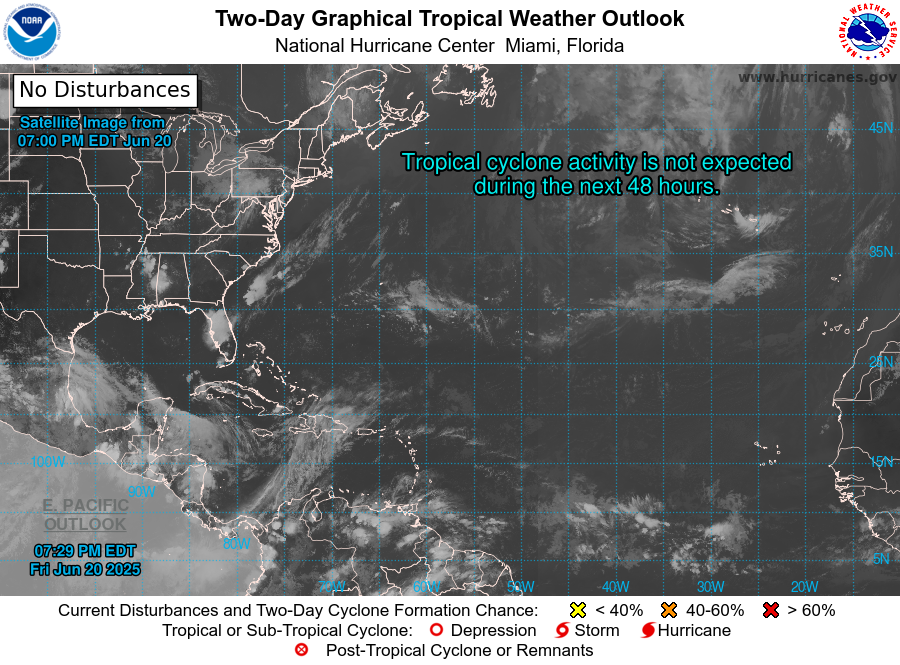
>>> Atlantic Ocean: There are no active tropical cyclones
1.) A large non-tropical low pressure system located several hundred miles west-northwest of the Azores is producing a broad area of gale-force to hurricane-force winds. The low could gradually acquire some subtropical characteristics over the next few days while it moves slowly southward to southeastward over warmer water. Environmental conditions are expected to become unfavorable for any further development by Friday when the low is forecast to move back over colder water.
* Formation chance through 48 hours…low…10 percent
* Formation chance through 5 days…low…20 percent
>>> Caribbean Sea: There are no active tropical cyclones
>>> Gulf of Mexico: There are no active tropical cyclones
Latest satellite image of the Caribbean Sea and the Gulf of Mexico
>>> Eastern Pacific: There are no active tropical cyclones
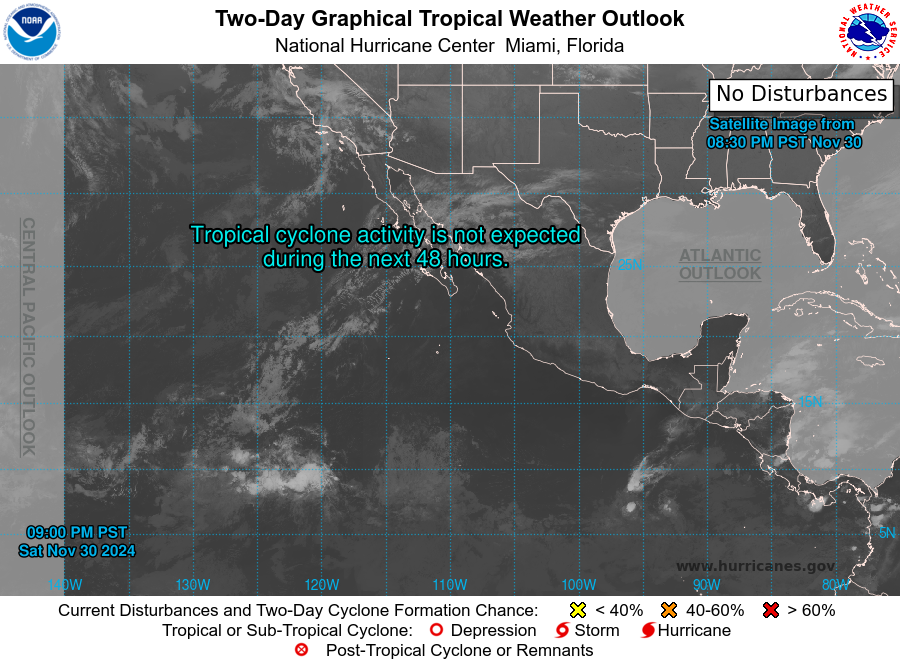
1.) Disorganized showers and thunderstorms located several hundred miles south of the southern coast of Mexico are associated with an elongated area of low pressure. Any development of this system should be slow to occur while it moves slowly westward to west-northwestward during the next several days.
* Formation chance through 48 hours…low…10 percent
* Formation chance through 5 days…low…20 percent
Here’s an animated color enhanced satellite image of the central and eastern Pacific
Here’s the link to the National Hurricane Center (NHC)
>>> Central Pacific: There are no active tropical cyclones
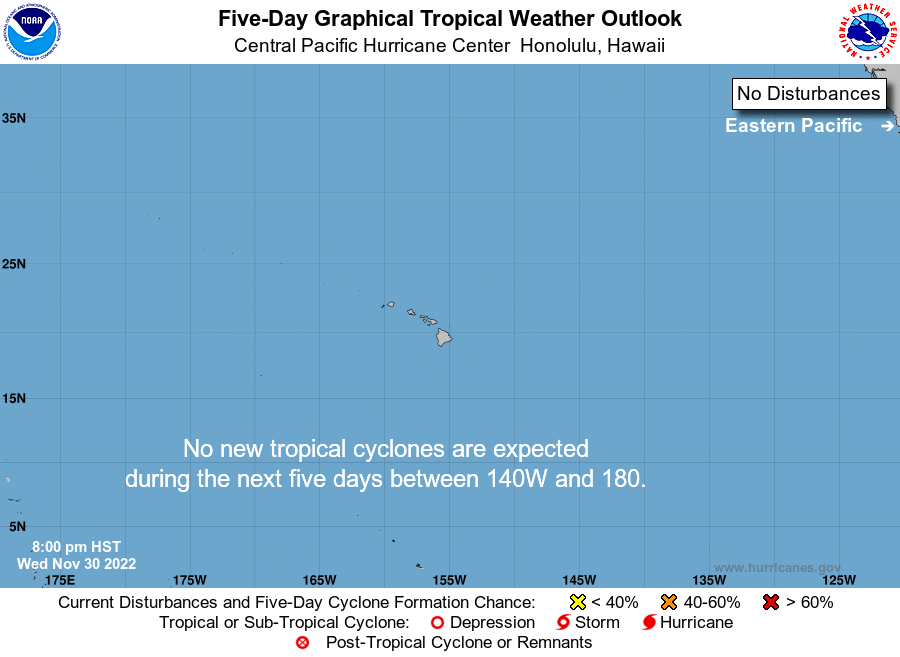
Here’s the link to the Central Pacific Hurricane Center (CPHC)
>>> Northwest Pacific Ocean: There are no active tropical cyclones
>>> South Pacific Ocean: There are no active tropical cyclones
>>> North and South Indian Oceans / Arabian Sea:
Tropical Cyclone 04A (Kyarr)
Sustained winds are 125 knots with gusts to 150 knots…as of warning 18
Here’s what the computer models are showing for this typhoon
Interesting: ‘Cuddlebots.’ Space-age masks. How future technology will help us sleep — Humans spend about one-third of their lives asleep — one-sixth if you have small children — and our built-in biological downtime is critical for health and happiness. Sleeping fewer than seven hours a day is associated with heart disease, stroke, diabetes, obesity, and high blood pressure, along with depression and various other mental disorders. And according to a study by the Centers for Disease Control and Prevention, more than one in three Americans is clinically sleep deprived.
Sociologists have all kinds of explanations for the crisis, but they all essentially boil down to… life itself. The modern American lifestyle — busy, stressful, powered by 24/7 artificial light and endless Information Age temptations — is the prime mover of sleep deprivation. Bedtimes have gotten later. (Thanks, Netflix.) Wake times have not. (Thanks, boss.) One widely cited 2013 Gallup poll crunched the archival numbers from previous surveys and found that Americans now sleep a full hour less than we did in 1942.
The good news is that an entire industry of sleep science and technology has developed in recent years to help us get more and better sleep. The future of when and where and how we sleep is changing, driven by shifting cultural priorities and emerging technologies.
Attitude and Awareness
A twinkly little silver lining to our national sleep epidemic is that we’re finally facing the problem. Thanks to public education campaigns, people are generally more aware of healthy sleep habits now than they were a generation ago. In an influential 2013 study titled “Raising Awareness of Sleep as a Healthy Behavior,” leading researchers concluded that “sleep should be viewed as being as critical to health as diet and physical activity.”
This call to arms (or pillows) has had a powerful economic ripple effect. On the consumer end of things, the global market for sleep tech products is expected to reach $76 billion in 2019.
For previous generations, sleep aids were limited to earplugs and sleep masks and scary prescription drugs. We can confidently expect the 21st century to offer much better options — some of them pretty space-age indeed.
Technology vs. Insomnia
The Dreamlight is a good example. A big hit at the 2018 Consumer Electronics Show, the device combines several different technologies designed to improve both the quantity and quality of your sleep.
Housed in a roomy and overstuffed sleep mask, the Dreamlight uses a network of circuitry to coordinate its many features. Embedded LED panels are designed to shine soft light through your eyelids when you fall asleep and when you wake up. According to the manufacturer’s research, dim orange lights trigger melatonin production at bedtime, helping you fall asleep. Green hues help you wake up in the morning. The Dreamlight mask also features four different embedded speakers, with timer options, for those who like to fall asleep to music or white noise or obscure BBC history podcasts. (Droning British historians are nature’s own built-in sleep remedy.)
The Dreamlight also includes infrared sensors, an optical heart rate monitor, and various gyroscopes and accelerometers designed to track how well you’re sleeping. The data are wirelessly beamed to the companion smartphone app, which offers analysis and suggestions. The company has also partnered with genomics company 23andMe to develop custom sleep profiles based on your genetic information.
Click around and you can find similar products online. Philips’ SmartSleep headband uses sensors and speakers to reinforce deep sleep via complementary audio tones. The Lumos sleep mask, developed at Stanford University, uses patterned light therapy to overcome jet lag and gradually reset your circadian rhythms.
Elsewhere, Bose is one of many companies now offering noise-canceling smart earbuds, which are essentially a future-facing iteration of sleep sound machines that have been around forever. (Ocean surf? Forest rain? Ambient dub?) These smart earbud kits go for around $100 to $250 and can include extras like heart monitoring, fitness tracking, and voice control.
The War on Snoring
If quality sleep has a recurring archvillain, it’s snoring — either your own or your partner’s. Happily, anti-snoring technology is moving past the traditional CPAP machines and dental appliances.
On the low-tech end, nasal dilators have proven effective for certain kinds of sleep apnea, and design advances are making chin straps an option for mouth-breathing snorers. Those dental appliances are getting better, too — more than 100 different designs have now received FDA clearance. This means more medical plans should cover costs in the future, according to the American Academy of Dental Sleep Medicine.
As for high-tech anti-snoring devices, one of the most successful solutions might be termed “artificial nudge technology.” If you share a bed with a snorer, you’re already proficient with the nudge. Elbow the snorer and they’ll usually (but not always!) shift position and stop snoring. (For a while! Maybe!)
There are now a dozen different products on the market that automate this process. These snort-prevention solutions — available in pillows, mattresses, and other devices — use sensors and microphones to listen for snoring, then automatically nudge, prod, or otherwise adjust the sleeper’s position. The industry veterans at Tempur Sealy recently announced a next-generation riff on the theme with an AI-powered bed that tracks the snorer’s sleep patterns and tries to anticipate snoring before it even occurs. Science!
Meanwhile, over in the Netherlands, a group of student entrepreneurs has developed what’s being billed as the world’s first “sleep robot.” A soft and “huggable” robotic pillow, the award-winning Somnox uses a technique called breathing regulation. Once you’re cuddled up, your body unconsciously synchronizes its breathing to the slow and steady rhythm of the sleepbot. It sounds crazy, but the Somnox team has published research to back up its claims.
In the Labs
Now that more people have an awareness of the serious health issues involved, sleep science labs around the world — both academic and commercial — are booming, busy, and expanding.
A major part of that expansion is taking sleep science into the home. According to a recent report by Johns Hopkins Medicine, future research will be increasingly reliant on technologies such as wearable tracking devices, portable sleep testing devices, and online doctor consultations in the home.
“The brick-and-mortar model of conducting sleep studies in a medical care center is really going to be fading into the sunset or will be minimal at best,” says Charlene Gamaldo, medical director of Johns Hopkins Center for Sleep, in the report.
This migration out of the labs is already underway. Sarah Ostadabbas, assistant professor of electrical and computer engineering at Northeastern University, is working on a mobile sleep testing system that can be set up in any bedroom, combining artificial intelligence with different sensor systems to make at-home sleep testing more accurate.
Using pressure mats and infrared cameras attached to the ceiling or a light fixture, the system tracks the patient’s sleep positions throughout the night. “Thermal imaging allows the system to track body heat even when the sleeper is underneath sheets and blankets,” Ostadabbas says.
Those images are run through a set of machine learning algorithms to create a data set, which allows doctors to diagnose specific sleep behaviors and problems.
Sleepy Students for Science!
Ostadabbas’ team recently recruited more than 100 Northeastern student volunteers to create an initial data set of more than 14,000 sleep position samples. They’re sharing the data sets and algorithms online in an open-source effort to help other sleep researchers worldwide.
The data will help researchers identify abnormal sleep behavior, Ostadabbas says. “Are there specific poses we can see that lead to specific complications?”
Ostadabbas notes that while the system can help the majority of us who sleep 33 percent of the time, it could be a truly critical advance for those in bed closer to 100 percent of the time — infants, the elderly, and patients with severe injury or illness.
Thermal imaging. LED sleep masks. Smart mattresses. Cuddlebots. From retail shelves to university labs, modern science is mobilizing to help us get a better night’s sleep. It’s a delicious proposition for anyone who appreciates 21st-century irony: Technology may be the greatest single cause of our national sleep epidemic. Can it be the solution, too?

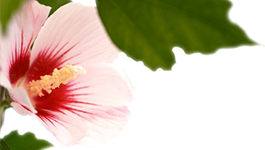











 Email Glenn James:
Email Glenn James:
Liu Says:
My husband and I are going to Kauai the first week in November for my h Birthday! Neither of us have been to Hawaii before so 134 days can t go fast enough!!
~~~ Hi Liu, isn’t November a few days more than 134 days? I hope it goes fast for you, and here’s a belated HB for you from last month.
You will love Kauai, it’s incredibly beautiful!
Happy New Year, Glenn
Eliza Bassett Says:
OMI! Wheee! Wind gusts started about 12:15 on the 22nd, Glenn. They are very variable, too. Starting as trades, suddenly showing south / kona(?). I was looking for mini vortices walking through the yard, the straight line gusts reminded me of that, yet nope. Something that hasn’t touched ground is moving the plants around. Then we’re back to small winds at the ground level. The nearby tall trees are being moved at their upper branches by the winds over there. Just amazing times. Trust this finds you well, and thanks for all you do here. Peace to all of us. ~ Eliza
~~~ Hi Eliza, wow, sounds very interesting! Up and down, this way and that…that sounds like variable wind speeds and directions to me. Thanks for the on-the-spot weather report there in Pukalani, Maui.
I’m well, and trust that you are too!
Aloha, Glenn
Eliza Says:
Aloha Glenn –
Trust this finds you well, as well as your mother being the same.
Was wondering if the prediction for the winter released from NOAA today will truly abate our drought difficulties. I’ve taken to watering the old ornamental olive trees 2x a week and I’m holding off planting young ti starts along a sunny fence line till these rains begin.
The crispy crunchy grass is not fun to walk on. :'(
Anyway, here’s to the never boring weather on this planet we call home.
Peace to all of us, Eliza
~~~ Hi Eliza, good to hear from you again. Crunchy dry grass underfoot, is not as pleasant as lush green grass…due to ample rainfall. Let’s hope that NOAA has this long term outlook correct, only time will tell. I’m sure you’ve noticed all the early season cold fronts approaching the islands this late summer/early fall…I’d say that’s a good sign.
We’ll be all watching this outlook together, my money is on wetter than average rainfall during this wet season.
Aloha, Glenn
Lance Says:
Aloha Glenn, as usual very much enjoy the great weather info and the site et al. Hope you are able to follow up on whatever it was that fell flaming to earth in Chile.
Lance
~~~ Hi Lance, good to hear from you. Yes indeed, if I see any further reports about that interesting article…I will post it here.
Aloha, Glenn
Gerry Says:
Aloha Glenn
Hot summer has been hard on us farmers…we are hoping for some cooling now that the days are shortening. How common historically have hurricanes or tropical storms hit the British Isles? Thinking of Lorenzo. Mahalo, Gerry
~~~ Hi Gerry, hot summer indeed! It takes awhile for the islands to finally have cooler weather. Autumn on the calendar doesn’t translate to much cooler weather here in Hawaii…until we reach November
Having tropical cyclones, either still active or in the dissipating stage, isn’t rare, although it’s certainly not common either. As I recall, there are usually one or two late seasons storms that do reach the British Isles…or into that general vicinity.
Aloha, Glenn